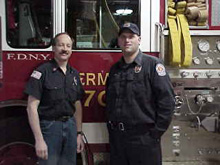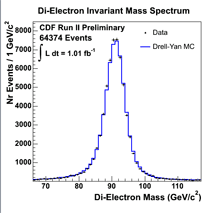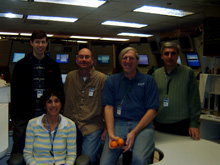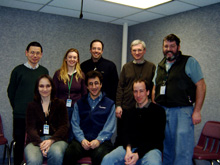 | Thursday, February 23, 2006 |
|
Thursday, February 23
Friday, February 24 |
|
Extended Forecast |
Secon Level 3 |
|
Thursday, February 23 -Southwestern Chicken Tortilla -Philly Style Cheese Steak -Chicken Pot Pie -Tomato Basil Chicken Parmesan -Southwestern Turkey Wrap -4 Cheese Pizza -Marinated Grilled Chicken Caesar Salads |
|
Thursday, February 23
Wednesday, March 1
Chez Leon Menu |
| Fermilab Today is online at: http://www.fnal.gov/today/ Send comments and suggestions to today@fnal.gov Fermilab Today archive Hurricane Relief Page Fermilab Today PDF Version Fermilab Result of the Week archive Fermilab Safety Tip of the Week archive Linear Collider News archive Fermilab Today classifieds Subscribe/Unsubscribe to |
|
Katrina Memories Still Vivid for Lab Firefighters |
||
|
||
|
Fermilab firefighters Lt. Chris Williams and Ryan Lambert had both received specialized training, such as dealing with mass casualty situations and hazardous materials, which made them eligible to volunteer in New Orleans with other local firefighters after Hurricane Katrina. Still, they felt nothing could have prepared them for what they encountered there: the heartbreak of helping someone salvage a keepsake from a home slimy with toxic sludge, the fear of being shot at while responding to a gas leak call in an unsecured area, the gratification of aiding New Orleans firefighters in their efforts to restore their city.
"When you do a job like ours, guys do it because they honestly want to help people," said Lambert, who has been a Fermilab firefighter for 5 years. "So when something like Katrina happens, everybody volunteers to help. Chris and I felt fortunate to go." But whether or not they could go was not entirely in their hands. "Without support from our families, from the lab, from Chief [Jack] Steinhoff, from people on our shifts... there's no way we could have done it," explained Williams, who has been a Fermilab firefighter for 15 years. Both men keep in touch with people they met in New Orleans. "They keep looking forward," Williams says. "Every little thing that happens, they look at it as a sign of progress." Among other correspondents, he has remained in contact with two of the sisters from Our Lady of Holy Cross College, where his team of firefighters camped. "They've opened up the college again," he says. "They're surprised how many students have returned and feel it's a good sign that young people are coming back."
Read full accounts of the firefighters' experiences on the Hurricane Relief page.
|
|
Grid Technology Helps UNOSAT Tackle Humanitarian Challenges
| ||
|
||
|
Patricia Mendez Lorenzo is part of the LHC Computing Grid's Experiment and Integration Support Team at CERN. Normally she supports the ALICE particle physics experiment, helping LCG sites to install and run the ALICE software. But last summer she was assigned an additional task: to help gridify satellite imagery applications for UNOSAT, a United Nations initiative that provides the humanitarian community with access to satellite imagery for use in crises such as earthquakes and tsunamis.
Read More |
|
ASCE Press Release,
February 21, 2006:
Neutrinos Project Nominated for National Outstanding Civil Engineering Achievement Award Reston, Va.—The world's first high-energy, long-baseline neutrino experiment, the Neutrinos at the Main Injector (NuMI) project—which runs from the Fermi National Accelerator Laboratory in Batavia, Ill., to the Soudan Underground Mine Park in northern Minnesota—has been named one of five finalists for the 2006 Outstanding Civil Engineering Achievement Award (OCEA), presented by the American Society of Civil Engineers (ASCE). This year's award winning project will be named at ASCE's 2006 Outstanding Projects and Leaders (OPAL) awards gala on April 26 at the Ronald Reagan Building and International Trade Center in Washington, D.C.
"The OCEA program recognizes projects on the basis of their resourcefulness in addressing planning and design challenges, as well as their impact on the environment, pioneering uses of materials and techniques, construction innovations and contribution to the well-being of people and their communities," said ASCE President Dennis R. Martenson, P.E., DEE, F.ASCE. "The civil engineering solution employed to facilitate the NuMI Project's scientific experiments is an exceptional example of everything the OCEA award embodies."
|
|
First 1-fb-1 Physics Result at a Hadron Collider |
|
Late last year, the lab celebrated reaching 1-fb-1 of luminosity delivered to the collider experiments. A few months later, CDF now celebrates its first physics result based on 1-fb-1 of acquired data. The result came in the form of a Z boson mass peak produced from e+e- events. There are now 64,374 Z candidates, which is 10 times more than in Run 1 at the Tevatron and more than 10,000 times that used in the discovery of the Z boson in 1983 by UA1.
This result was possible due to the excellent performance of the Tevatron and whole accelerator complex, the efficient data taking by CDF, the fast data calibration and processing, and the availability of large computing facilities for data analysis.
CDF is now looking forward to many physics results using 1-fb-1 of data. The high quality of the Z mass peak in the recent data gives CDF confidence that all the data can be understood quickly to be used for many analyses. Thus many physics results using more than 1-fb-1 of CDF data are expected soon, hopefully with some exciting surprises awaiting!
|
| Result of the Week Archive
|
|
February 20 - 22 - Two stores provided 22 hours and 51 minutes of luminosity. - TeV quenched with no store. - Store 4658 lost due to vacuum trouble. Read the Current Accelerator Update Read the Early Bird Report View the Tevatron Luminosity Charts
|
|
Professional Development Schedule:
Blood Drive Results
NALWO - Folk Dance Potluck
|




